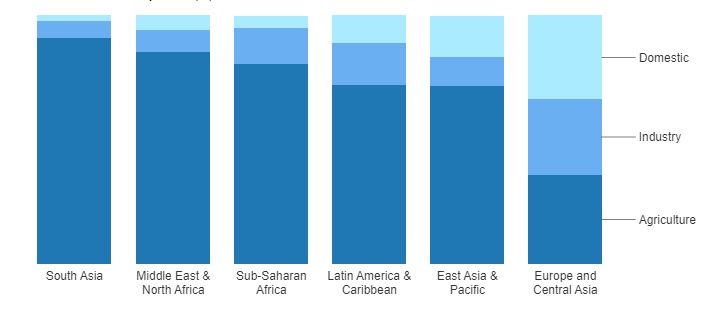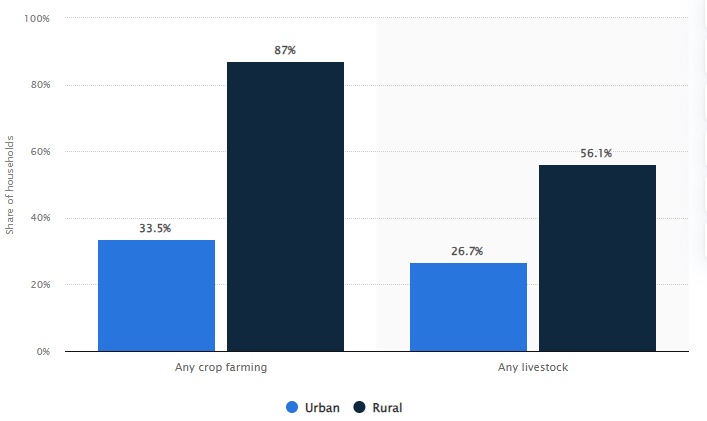Severe water scarcity in Africa poses a threat to the economy of rural communities, the continent’s monetary poverty rate and the actualization of the UN Sustainable Development Goal (SDG) 1 by 2030. This is due to the significant role that agriculture plays in driving the livelihood of the continent’s vast rural population, who are predominantly farmers.
Water scarcity is the lack of freshwater resources to meet standard water demand, which according to IRC Wash is at least 50 liters per person per day. As the population of the world grows and the environment becomes further affected by climate change, access to fresh water is declining. However, this challenge affects all climes to varying degrees, depending on their water resource management systems, economic development, extent of climate change vulnerability, and technological advancement. Only 30% of Europe’s population, for example, faces water scarcity, whereas, 1 in 3 persons in Africa do not have access to water and approximately 400 million people in sub-Saharan Africa lack access to basic drinking water. This is because, unlike Europe, Africa is extremely susceptible to the impacts of climate change such as prolonged droughts, unpredictable rainfall patterns, etc. It also faces inadequate access to the resources required to invest and maintain the infrastructure that can enhance smooth adaptation to the aggravating water crisis.
Hence, severe water scarcity has far-reaching impacts on the African continent, especially on agriculture. Agriculture is a mainstay in Africa to Africa, and in addition to being a major source of revenue for many African countries, it is the backbone of the economy of rural communities. However, it highly depends on the adequate supply of fresh water to thrive. In Sub-saharan Africa, agriculture alone accounts for over 70% of freshwater used. (see figure 1).

As a result of an inability to meet the heavy demands of freshwater supply, all categories of farmers in Africa – crop, livestock and aquaculture are experiencing a significant decline in production and profit. A report by Thisday Newspaper shows that about 60% of farmers across the 34 local government areas of Katsina State, Nigeria lost more than 1.7 million metric tonnes of grains as a result of severe drought. In addition, a Kenyan government report shows that fish farmers in sections of Lake Victoria lost more than 900 million Kenyan shillings ($7.2 million) in massive fish kills. More than 62,000 livestock also died in Tanzania due to drought in the northeast Manyara region. This consequent loss and overall difficulty in agricultural practices due to severe water scarcity in the continent hamper the livelihood of the rural population and the economy of rural communities. Agriculture is an indigenous skill that is passed from one generation to the other and it is predominantly practiced by the rural population. A World Bank study reports that roughly 90% of the rural households across 10 African countries it studied are engaged in agriculture. In addition, a survey by Statista shows that only 33.5% of urban households in Nigeria practice crop farming, while about 87% in rural areas are engaged in crop farming (see Figure 2). This infers that a significant portion of Africa’s rural population depends on agriculture to feed and generate income, and water scarcity increasingly poses a major threat to their means of livelihood as individuals and their economy as a community.
 Figure 2: Share of households participating in agricultural activities in Nigeria in 2019, by type and by area
Figure 2: Share of households participating in agricultural activities in Nigeria in 2019, by type and by area
Source: Statista
Due to the vastness of Africa’s rural population, this threat consequently projects a wider impact on the continent’s monetary poverty rate and the actualization of SDG 1 by 2030. Monetary poverty is the dimension of poverty that specifically captures a household’s ability to meet critical basic needs in food, shelter, clothing and other goods that are commonly obtained through market purchase. The international poverty line, which is currently $2.15 per person per day, is the threshold that determines whether someone is experiencing monetary poverty, and according to the Food and Agriculture Organization of the UN, 82% of households in Africa already live below this threshold, of which 70% are farmers spread across different African countries. As severe water scarcity results in the fall of agricultural production, farmer’s profits and inability to afford basic needs, the continent’s monetary poverty rate could experience a further spike, especially because the rural population, which is predominantly made up of farmers, accounts for over 50% of the continent’s overall population. On a global level, this might impede the efforts of the international community to achieve SDG 1, which aims to end poverty by 2030. Reports show that in comparison with other regions, Africa is making slow progress on this goal due to the effects of COVID-19, the war in Ukraine, food insecurity and other social challenges. Water scarcity might further delay this progress.
These impacts show the multifaceted role that water plays in Africa and the actualization of SDG 1. Solving the challenge of water scarcity in the long term on the continent requires large financial resources to invest in and maintain water harvesting infrastructure, as well as sound water management systems and policies. To achieve this, there is a need for strong collaboration at all levels. Governments in Africa need to collaborate with the private sector to create innovative solutions, in addition to forming stronger partnerships among themselves and with the international community.
About the Author(s)
Olayide Oyeleke is an associate at The AR Initiative; where Dr Emma Etim is the Head of Research.